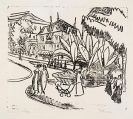
Gerrit Thomas Rietveld
Utrecht
1888 -
Utrecht
1964
Born in Utrecht in 1888, the Dutch designer, architect and painter Gerrit Rietveld spent his entire life in the city of his birth. The son of a carpenter, Gerrit Rietveld was employed in his father's workshop until he was fifteen. Until 1913 Gerrit Rietveld was employed as a draftsman in the workshop of the goldsmith C.J.A. Begeer. From 1906, Gerrit Rietveld also attended evening courses, where he learned technical draftsmanship from the architect P.J.C. Klaarhamer.
In 1911-12 Gerrit Rietveld was a member of the group of artists known as Kunstliefde, with whom he also showed work. In 1917 Gerrit Rietveld established a furniture workshop in Utrecht. By 1919, however, Gerrit Rietveld had joined Theo van Doesburg, Piet Mondrian, and other artists to found "De Stijl"; Rietveld would become one of the most important and influential artists in that celebrated group. The "De Stijl" artists formulated a language of forms that was intended to attain the greatest objectivity and autonomy in a work of art; their works are stringently non-representational, radically reduced to a geometric arrangement of horizontals and verticals and a palette consisting of the primary colors red, yellow, and blue with the addition of black and white. De Stijl applied these principles to both two-dimensional and three-dimensional work, such as furnishings and architecture.
In 1919 Gerrit Rietveld designed the prototype of his famous "Red and Blue" chair, which, however, was not given the striking lacquering that is so typical of De Stijl until 1923. The "Red and Blue" chair consists of straight boards and battens; the seat is lacquered blue and the back red. The cut surfaces of the frame battens are yellow; the battens themselves black. Gerrit Rietveld himself seems to have viewed his chair as a work of art since he called it a "spatial creation", designating a sculpture in space, rather than a piece of furniture. The "Red and Blue" chair was shown in the journal "De Stijl" and was also exhibited in a show mounted by the Bauhaus, where it made quite an impact.
In 1924-25 Gerrit Rietveld designed the "Schröder House" for Truus Schröder in Utrecht, a building that would become the architectural manifesto of the De Stijl movement. The colors, the division and arrangement of surfaces on the two floors of this private house faithfully follow the De Stijl principles.
Between 1932 and 1934, Gerrit Rietveld designed the "Zig-Zag" chair, which consists in four simple boards fitted together at oblique angles. In 1922, in connection with the practice he was designing for Dr. Hartog in Maarssen, Gerrit Rietveld designed a tubular ceiling lamp of white soffits arranged at right angles with black cubes at the ends for fastening the straight wires on which it was suspended from the ceiling.
In 1928 Gerret Rietveld became a member of the Congrès International d'Architecture Moderne (CIAM). As an architect plant, Gerrit Rietveld designed many buildings and interiors. His biggest project, however, the Van Gogh Museum in Amsterdam, was not completed until nine years after he died in 1964.
Would you like to sell a work by Gerrit Thomas Rietveld?
Infos for seller












